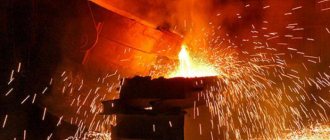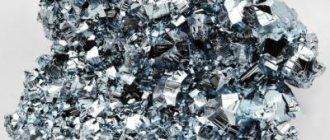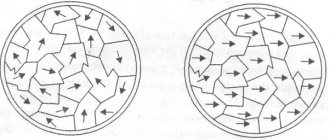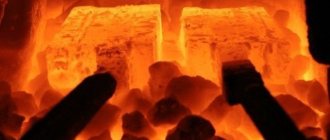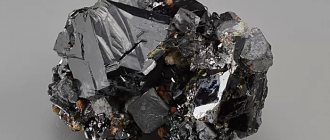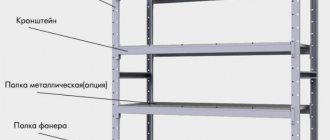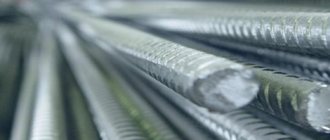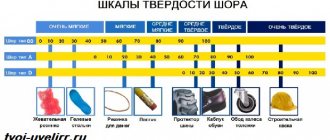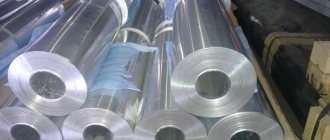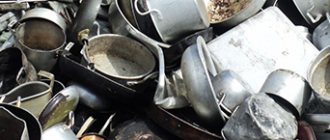Density tables for some substances
The density table is the first table of values of physical quantities that you become familiar with. In the previous paragraph, you learned how to “create” similar tables - carrying out numerous measurements and subsequent calculations.
You already know that when temperature changes, the volume of bodies changes. As a result, the density also changes. For example, at 0°C and normal atmospheric pressure, the mass of 1 m³ of air is 1.3 kg, and at 100°C, due to thermal expansion, 950 g of air is placed in 1 m³ (see figure). Therefore, in tables with density values, temperature is always indicated (see tables below).
The density of all substances also depends on the pressure exerted on them. For example, at an altitude of 10 km, the atmospheric pressure is much lower than near the ground, as a result of which the mass of 1 m³ of air there is only about 400 grams. The density of solids and liquids is much less dependent on pressure than the density of gases.
The right column of solids contains metals (see table). As you can see, the density of metals is several thousand kilograms per cubic meter. For example, the density of lead is 11300 kg/m³. This value can be written shorter if expressed in other units, for example: 11.3 g/cm³. Let us explain how this “translation” of one unit into another is done:
| 11300 | kg | = | 11300 kg | = | 11300 1000 g | = | 11300000 g | = | 11.3 g | = 11.3 g/cm³ | ||
| m³ | (100 cm)³ | 100³ cm³ | 1000000 cm³ | 1 cm³ |
The lower table shows the densities of gases and liquefied gases. Notice how significantly the density of the gas and the resulting liquid differs: air, nitrogen and oxygen are denser by approximately 700 times, hydrogen and helium by 800 times. Note: carbon dioxide, when cooled at atmospheric pressure, turns from a gaseous state immediately into a solid, which is why you see a dash in the table.
| Solids: density, kg/m³ (at 20 °C) | ||||
| Dry concrete | 2300 | Aluminum | 2700 | |
| Dry brick | 1800 | Gold | 19000 | |
| Ice, 0°C | 900 | Brass | 8300-8700 | |
| Marble | 2600-2800 | Copper | 8900 | |
| Paraffin | 900 | Tin | 7300 | |
| Cork | 240 | Lead | 11300 | |
| Dry pine | 500 | Silver | 10500 | |
| Window glass | 2500 | Steel | 7700-7900 | |
| Organic glass | 1200 | Cast iron | 7000-7800 | |
| Porcelain | 2300 | Zinc | 7100 | |
| Bulk solids: density, kg/m³ (at 20 °C) | ||||
| Gravel | 1500-1700 | Sand | 1200-1700 | |
| Potato | 660-680 | Coal | 800-850 | |
| Liquid substances: density, kg/m³ (at 20 °C) | ||||
| Acetone | 780 | Cow's milk | 1030 | |
| Petrol | 730 | Fresh honey | 1350 | |
| Fresh water | 1000 | Oil | 730-940 | |
| Sea water | 1030 | Mercury | 13500 | |
| Kerosene | 800 | Ruth, 0°С | 13600 | |
| Machine oil | 910 | Ethanol | 790 | |
| Sunflower oil | 930 | Ethyl ether | 710 | |
| Gases (at 20 °C) and liquefied gases, kg/m³ | ||||||
| Nitrogen | 1,25 | 850 | Helium | 0,18 | 147 | |
| Hydrogen | 0,09 | 72 | Oxygen | 1,43 | 1150 | |
| Air | 1,29 | 861 | Carbon dioxide | 1,98 | – | |
Specific gravity of aluminum alloys in the table
Specific gravity of aluminum alloys depending on types
| Type of aluminum | Aluminum grade | Specific gravity in g/cm3 |
| Primary aluminum | A5 | 2,71 |
| A85 | 2,71 | |
| A95 | 2,71 | |
| A97 | 2,71 | |
| A99 | 2,7 | |
| A999 | 2,7 | |
| Technical aluminum | AD1 | 2,71 |
| AD0 | 2,71 | |
| HELL | 2,71 | |
| Cast aluminum | AL1 | 2,75 |
| AL2 | 2,65 | |
| AL3 | 2,7 | |
| AL4 | 2,65 | |
| AL5 | 2,65 | |
| AL7 | 2,68 | |
| AL8 | 2,55 | |
| AL9 | 2,66 | |
| AL19 | 2,78 | |
| AK5M7 | 2,85 | |
| VAL10 | 2,8 | |
| Wrought aluminum alloy | 1420 | 2,47 |
| AB | 2,7 | |
| AD31 | 2,71 | |
| AD33 | 2,71 | |
| AK4 | 2,77 | |
| AK4-1 | 2,8 | |
| AK6 | 2,75 | |
| AK8 | 2,8 | |
| AMg1 | 2,67 |
Introduction to Mass Calculations
Home > Mass Calculation > Introduction to Mass Calculation
05/04/2013 // Vladimir Trunov
When dealing with precious metal, you have to constantly worry about its consumption. Often you want to know in advance how much a product will weigh approximately before it is manufactured. In most cases this can be calculated.
This section contains several articles with formulas for calculating the mass of parts of various shapes. Why masses and not weights? Short answer: grams of mass are represented by the letter "g" and grams of weight are represented by the letter "G", and I'm too lazy to press Shift. Long answer: mass is a more fundamental characteristic of an object than its weight. For example, a ring weighing 10 g on Earth will weigh 10 G, and on the Moon - only 1.65 G. Moreover, even on Earth, the weight of an object changes depending on our location: what weighs a ton at the pole, at the equator will weigh only 995 kg. Therefore, it makes sense to buy potatoes at the equator and sell them at the pole. And that’s why it makes sense to calculate exactly the mass of the product, and not its weight. And, again, you won’t have to press Shift again.
The general approach to calculating the mass of a part is to calculate its volume, which is then multiplied by the density of its material. Density is the mass of one cubic centimeter of this material. Below are tables of density values for some metals and alloys.
A few words about units of measurement. Dimensions in jewelry are usually measured in millimeters, so the volume obtained from the formulas will be measured in cubic millimeters. And since density is expressed in grams per cubic centimeter , then our volume must be divided by 1000 before multiplying it by density (in one cubic centimeter there are 1000 cubic millimeters, although you might not think right away!).
One final note. The mass values obtained from the formulas may differ from the real ones by several percent. This is not because the formulas are not accurate, but because in life everything is a little more complicated than in mathematics: right angles are not quite right, circles and spheres are not ideal, deformation of the workpiece during bending, embossing and hammering leads to unevenness of its thickness , and you can list a bunch more deviations from the ideal. The final blow to our desire for precision comes from grinding and polishing, which lead to unpredictable weight loss in the product. Therefore, the obtained values should be treated as indicative.
Density of metals
Density of gold alloys
Density of silver alloys
Density of copper alloys
mass calculation, jewelry alloys
Weight of the wedding ring
Weight of wire, rod, rolled stock
Weight of ring, link
Related Posts
Density units
The official SI unit for density is kg/m³. Since this is a fairly large volume, for convenience they most often use
- g/cm³ for solids,
- g/ml for liquids,
- g/l for gases.
The density of water is approximately 1 gram/cubic centimeter. It is taken as the standard value for calculations.
Other units of density
Other units of measurement for density include metric tons and liters, although they are not included in the SI International System. Other units include:
- gram per milliliter (g/ml)
- metric ton per cubic meter (t/m³)
- kilogram per liter (kg/l)
- megagram (metric ton) per cubic meter (mg/m³)
- grams per cubic centimeter (g/cm³) 1g/cm³ = 1000 kg/m³
- kilogram per cubic decimeter (kg/dm³)
To make a quick and accurate conversion from one value to another, you can use our density converter.
Directory
Density of solids and liquids
| Substance | Density g/ml = 103 kg/m3 | Substance | Density g/ml = 103 kg/m3 |
| Agate | 2,6 | Cork | 0,25 |
| Alabaster | 1,8 | Mercury | 13,6 |
| Aluminum | 2,7 | Salo | 0,9 |
| Diamond | 3,5 | Lead | 11,3 |
| Asbestos | 2,4 | Silver | 10,3 |
| Asphalt | 1,4 | Turpentine | 0,85 |
| Acetone | 0,8 | Mica | 2,8 |
| Petrol | 0,7 | Resin (gum) | 1,1 |
| Borax | 1,7 | → black | 1,1 |
| Var | 1 | Denatured alcohol | 0,8 |
| Sea water | 1,03 | → ethyl | 0,8 |
| Wax (laboratory) | 1 | Alcohol | 0,79 |
| → bee | 0,95 | Soft steel | 7,9 |
| Germanium | 5,4 | → carbonaceous (<1% C) | 7,8 |
| Glycerol | 1,3 | Sealing wax | 1,8 |
| Granite | 2,7 | Alloys | |
| Graphite | 2,3 | → Alni | 6,9 |
| Dry wood | → Alnico | 7,1 | |
| → Backout | 1,3 | → Babbitt (80% Sn) | 7,3 |
| → Balsa (cork) | 0,2 | → Aluminum bronze (8% Al) | 7,7 |
| → Bamboo | 0,4 | → → phosphorous | 8,9 |
| → Beech | 0,75 | → Duralumin | 2,8 |
| → Oak | 0,7 | → Stainless iron (12% Cr) | 7,7 |
| → Cedar | 0,55 | → Mirror bronze | 8,4 |
| → Mahogany | 0,8 | → Invar | 8 |
| → Boxwood | 1 | → Inconel | 8,5 |
| → Pine (white) | 0,5 | → Constantan | 8,9 |
| → Teak wood | 0,85 | → Cronit | 8,1 |
| → Ebony | 1,2 | → Brass (60/40) | 8,4 |
| Gelatin | 1,3 | → → (70/30) | 8,5 |
| Silicon iron | 6,9 | → Lo-Ex | 2,7 |
| → welding | 7,8 | → Magnalium | 2,6 |
| Ash (wood) | 0,75 | → Mazak (No. 2) | 6,7 |
| Gold (22 carat) | 17,5 | → Manganin | 8,5 |
| → (9 carats) | 11,3 | → Beryllium copper | 8,2 |
| Tungsten Carbide (6% CO) | 15 | → Monel | 8,8 |
| → tungsten (12% CO) | 14,2 | → Mu-metal | 8,8 |
| Crystalline quartz | 2,6 | → German silver | 8,4 |
| → melted translucent | 2,1 | Nickel-silver | 8,8 |
| → → transparent | 2,2 | Nickel-chrome | 8,4 |
| Quartz sand (pure) | 2,6 | Nikonik | 8,2 |
| Keramot | 1,6 | Permalloy | 8,6 |
| Kerosene | 0,8 | Platinum-iridium (90/10) | 21,5 |
| Kaolin | 2,6 | Prina soft (70% Sn, 30% Pb) | 8,3 |
| Corundum | 4 | Alloy "Y" | 2,8 |
| Bone | 1,9 | Supermalloy | 8,9 |
| → ivory | 1,8 | Gunmetal | 8,2 |
| Silicon | 2,4 | Elinvar | 8,1 |
| Xylene | 0,85 | Thiokol | 1,4 |
| Ice | 0,92 | Coal (anthracite) | 1,6 |
| Animal oil | 0,9 | → (bituminous) | 1,4 |
| → castor | 0,95 | → (woody) | 0,4 |
| → flaxseed | 0,95 | → (retort) | 1,9 |
| → olive | 0,9 | White spirit | 0,85 |
| → paraffin | 0,8 | Porcelain | 2,3 |
| Copper | 8,9 | Chromium | 7,2 |
| Micalex | 2,4 | Cast iron | 7 |
| Milk | 1,03 | Slate | 2,8 |
| Marble | 2,7 | Ebonite | 1,2 |
| Emery | 4 | Amber | 1,1 |
| Oil | 0,8 | ||
| Nichrome | 8,4 | ||
| Tin | 7,3 | ||
| Paraffin | 0,9 | ||
| Sand (dry) | 1,6 | ||
Density of gases and vapors
| Substance | Formula | Density g/ml = 103 kg/m3 | Substance | Formula | Density g/ml = 103 kg/m3 |
| Nitrogen | N2 | 1.2505 | Neon | Ne | 0.8999 |
| Ammonia | NH3 | 0.7714 | Nitrosyl | ||
| Argon | Ar | 1.7839 | → fluoride | NOF | 2.176* |
| Acetylene | C2H2 | 1.1709 | → chloride | NOCl | 2.992 |
| Boron fluoride | BF3 | 2.99 | Ozone | O3 | 2.22 |
| n-Butane | C4H10 | 2.703 | Nitric oxide | NO | 1.3402 |
| i-Butane | C4H10 | 2.673 | Propane | C3H8 | 2.0037 |
| Hydrogen | H2 | 0.08987 | Propylene | C3H6 | 1.915 |
| → bromide | HBr | 3.664 | Radon | Rn | 9.73 |
| → iodide | Hl | 5.789 | Sulfur | ||
| → arsenic | H3As | 3.48 | → dioxide | SO2 | 2.9263 |
| → selenium | H2Se | 3.6643 | → hexafluoride | SF6 | 6.50* |
| → sulfurous | H2S | 1.5392 | Silan | ||
| → telluride | H2Te | 5.81 | → dimethyl | SiH2(CH3)2 | 2.73 |
| → phosphorous | H3P | 1.53 | → methyl | SiH3CH3 | 2.08 |
| → chloride | HCl | 1.6391 | → chloride | SiH3Cl | 3.03 |
| Air | — | 1.2928 | → trifluoride | SiHF3 | 3.89 |
| Helium | He | 0.1785 | Stibine (15°C, 754 mmHg) | SbH3 | 5.3 |
| Germany tetrahydride | GeH4 | 3.42 | Sulfuryl fluoride | SO2F2 | 3.72* |
| Dimethyl sulfide | C2H6S | 0.848* | Trimethylamine | (CH3)3N | 2.580* |
| Dimethyl disulfide | (CH3S)2 | 1.062* | Trimethylboron | (CH3)3B | 2.52 |
| Dimethylamine | (CH3)2NH | 1.966* | Carbon | ||
| Difluorodichloromethane | CF2Cl2 | 5.51 | → dioxide | CO2 | 1.9768 |
| Dician | C2N2 | 2.335* | → oxide | CO | 1.25 |
| Nitrous oxide | N2O | 1.978 | → sulfur dioxide | COS | 2.72 |
| Oxygen | O2 | 1.42904 | Phosphorus | ||
| Silicon | → fluoride | PF3 | 3.907* | ||
| → fluoride | SiF4 | 4.9605 | → oxyfluoride | POF3 | 4.8 |
| → hexahydride | Si2H6 | 2.85 | → pentafluoride | PF5 | 5.81 |
| → tetrahydride | SiH4 | 1.44 | Fluorine | F2 | 1.695 |
| Krypton | Kr | 3.74 | Nitrogen fluoride | NO2F | 2.9 |
| Xenon | Xe | 5.89 | Chlorine | Cl2 | 3.22 |
| Methane | CH4 | 0.7168 | → dioxide | ClO2 | 3.09* |
| Methylene chloride | CH3Cl | 2.307 | → oxide | Cl2O | 3.89* |
| Methylamine | CH5N | 1.388 | Nitrogen oxychloride | NO2Cl | 2.57 |
| Methyl mercaptan | CH3SH | 0.87 | Ethane | C2H6 | 1.356 |
| Methyl ether | C2H6O | 2.1098 | Ethylene | C2H4 | 1.2605 |
| Methyl fluoride | CH3F | 1.545 | |||
| Methyl chloride | CH3Cl | 2.307 | |||
| Arsenic fluoride | AsF5 | 7.71 | |||
Note: Reference data is sourced from online publications and may not be considered "official" or "completely accurate." As a rule, Internet directories do not provide links to scientific works that are the basis of published data. We try to take information from the most reliable scientific sites. However, if anyone is interested in links to experiments, we advise you to conduct an in-depth search on the Internet yourself. We will be grateful for any comments on our reference tables, and especially for clarification of existing information or addition of reference data.
Specific Gravity of Gemstones (Density Table)
Gemstone specific gravity is a designation for the relative density of a piece of jewelry or gemstone.
Every jeweler knows from experience that some stones are “by weight” heavier than others. For example, colorless zircon weighs more than a diamond of the same size, and sapphire weighs more than an emerald. Scientists have long learned to express this quality quantitatively, and this plays a big role in recognizing substances. Water was used as a standard, and the weight of each substance was compared with the weight of an equal volume of pure water. The number obtained as a result of this comparison is called the specific gravity, or relative density of the substance. Thus, the specific gravity of a body is the ratio of its weight to the weight of pure water of equal volume. To obtain accurate data, water at a temperature of 4°C is used as a standard.
Table of specific gravity of precious stones and jewelry materials
The reference table provides specific gravity (or relative density) values for over 100 gemstones and jewelry materials.
| Gemstone | Specific gravity | Gemstone | Specific gravity |
| Aquamarine | 2,69 | Nephritis | 2,96 |
| Axinite | 3,28 | Obsidian | 2,35 |
| Diamond | 3,52 | Fire opal | 2,00 |
| Almandine | 4,2 | Opal | 2,1 |
| Amazonite | 2,56 | Orthoclase | 2,56 |
| Amblygonitis | 3,03 | Palladium | 11,3 |
| Anataz | 3,88 | turtle shell | 1,30 |
| Andalusite | 3,15 | Painite | 4,01 |
| Apatite | 3,21 | Periclase (synthetic) | 3,59 |
| Aragonite | 2,94 | Petalite | 2,39 |
| Bakelite | 1,26 | Pyrite | 4,9 |
| Barite | 4,5 | Pyrope | 3,7 |
| Benitoite | 3,67 | Platinum | 21,5 |
| Beryl (yellow) | 2,69 | Pleonastus | 3,8 |
| Beryllonite | 2,82 | Pollucite | 2,92 |
| Turquoise | 2,8 | Prehnite | 2,87 |
| Bowenite | 2,6 | Pseudofit | 2,7 |
| Brazilianite | 2,99 | Vegetable bone | 1,40 |
| Variscite | 2,55 | (yellow) | 3,56 |
| Vesuvian | 3,38 | Rodicite | 3,40 |
| Verdit | 2,9 | Rhodonite | 3,6 |
| Willemite | 4,03 | Rhodochrosite | 3,6 |
| Hambergite | 2,35 | Rutile (synthetic) | 4,25 |
| Ganospinel | Up to 3.97 | Silver | 10,5 |
| YYY | 7,05 | Singalit | 3,48 |
| Hematite | 5,05 | Scapolite yellow | 2,70 |
| Hessonite | 3,65 | Scapolite pink | 2,63 |
| Grossular | 3,5 | Ivory | 1,8 |
| Danburite | 3,00 | Smithsonite | 4,35 |
| Datolite | 2,95 | Sodalite | 2,3 |
| Demantoid | 3,85 | Sun stone | 2,64 |
| Diopside | 3,29 | Spessartine | 4,16 |
| Dioptase | 3,30 | Spodumene | 3,18 |
| Jade | 3,33 | Staurolite | 3,70 |
| Pearls (cultured) | 2,75 | Sphalerite | 4,09 |
| Pearl (oriental) | 2,71 | Sphene | 3,53 |
| Pearl pink | 2,85 | Talc | 2,75 |
| Gold 375 Ave. | 11,4 | Taffeite | 3,61 |
| Gold 583 Ave. | 13,93 | Strontium titanate | 5,13 |
| Gold 750 pr. | 15,4 | Topaz (white) | 3,56 |
| Gold 916 Ave. | 17,7 | Topaz (yellow) | 3,53 |
| Pure gold | 19,3 | Tourmaline | 3,06 |
| Emerald | 2,71 | Phenakite | 2,96 |
| Emerald (synthetic) | 2,65 | Fibrolite | 3,25 |
| Iolite | 2,59 | Fluorite | 3,18 |
| Calcite | 2,71 | Chalcedony | 2,6 |
| Carborundum | 3,17 | Chrysoberyl | 3,71 |
| Cassiterite | 6,9 | Chrysocolla | 2,20 |
| Quartz | 2,65 | Chrysolite | 3,34 |
| Quartz glass | 2,21 | Celluloid | 1,38 |
| Kyanite | 3,68 | Zircon (blue and colorless) | 4,69 |
| dug | 1,06 | Zircon (green) | 4-4,5 |
| Coral | 2,68 | Zoisite | 3,1 |
| Cornerupin | 3,32 | Zoisite (blue) | 3,35 |
| Corundum | 3,99 | Sheelit | 6,0 |
| Bone | 2,0 | Spinel | 3,60 |
| Cubic zirconia | 5,6-5,9 | Spinel (synthetic) | 3,63 |
| Labrador | 2,70 | Euclase | 3,10 |
| Lazulite | 3,09 | Ekanite | 3,28 |
| Lapis lazuli | 2,8 | Enstatite | 3,27 |
| Leucite | 2,47 | Epidote | 3,45 |
| Moon rock | 2,57 | Erinoid | 1,33 |
| Malachite | 3,8 | Amber | 1,08 |
| Modzavit | 2,35 | ||
| Note. When the specific gravity value varies by more than one or two units in the second decimal place, only one decimal place is given. | |||
____________
A source of information:
1. AndersonB. Definition of precious stones: Transl. from English /-Moscow, World of Stone 1996
2. DICTIONARY OF GEOLOGICAL TERMS AND CONCEPTS. / - Tomsk: 1996.
Table of density, thermal conductivity and vapor permeability of various building materials
The table shows average values for materials from various manufacturers.
| Material | Density, kg/m3 | Thermal conductivity, W/(m*S) | Vapor permeability | Equivalent1 (with heat transfer resistance = 4.2m2*C/W) thickness, m | Equivalent2 (with vapor permeation resistance = 1.6 m2*h*Pa/mg) thickness, m |
| Mg/(m*h*Pa) | |||||
| Reinforced concrete | 2500 | 1,69 | 0.03 | 7,10 | 0.048 |
| Concrete | 2400 | 1,59 | 0.03 | 6,34 | 0.048 |
| Expanded clay concrete | 1800 | 0.66 | 0.09 | 2,77 | 0.144 |
| Expanded clay concrete | 500 | 0.14 | 0.30 | 0.59 | 0.48 |
| Red clay brick | 1800 | 0.56 | 0.11 | 2,35 | 0.176 |
| Brick, silicate | 1800 | 0.70 | 0.11 | 2,94 | 0.176 |
| Ceramic hollow brick (gross 1400) | 1600 | 0.41 | 0.14 | 1,72 | 0.224 |
| Ceramic hollow brick (gross 1000) | 1200 | 0.35 | 0.17 | 1,47 | 0.272 |
| Foam concrete | 1000 | 0.29 | 0.11 | 1,22 | 0.176 |
| Foam concrete | 300 | 0.08 | 0.26 | 0.34 | 0.416 |
| Granite | 2800 | 3,49 | 0.008 | 14,6 | 0.013 |
| Marble | 2800 | 2,91 | 0.008 | 12,2 | 0.013 |
| Pine, spruce across the grain | 500 | 0.09 | 0.06 | 0.38 | 0.096 |
| Oak across the grain | 700 | 0.10 | 0.05 | 0.42 | 0.08 |
| Pine, spruce along the grain | 500 | 0.18 | 0.32 | 0.75 | 0.512 |
| Oak along the grain | 700 | 0.23 | 0.30 | 0.96 | 0.48 |
| Plywood | 600 | 0.12 | 0.02 | 0.50 | 0.032 |
| Chipboard, OSB | 1000 | 0.15 | 0.12 | 0.63 | 0.192 |
| TOW | 150 | 0.05 | 0.49 | 0.21 | 0.784 |
| Drywall | 800 | 0.15 | 0.075 | 0.63 | 0.12 |
| Cardboard facing | 1000 | 0.18 | 0.06 | 0.75 | 0.096 |
| Minplita | 200 | 0.070 | 0.49 | 0.30 | 0.784 |
| Minplita | 100 | 0.056 | 0.56 | 0.23 | 0.896 |
| Minplita | 50 | 0.048 | 0.60 | 0.20 | 0.96 |
| EXTRUDED POLYSTYRENE FOAM | 35 | 0.031 | 0.013 | 0.13 | 0.021 |
| EXTRUDED POLYSTYRENE FOAM | 45 | 0.036 | 0.013 | 0.13 | 0.021 |
| Styrofoam | 150 | 0.05 | 0.05 | 0.21 | 0.08 |
| Styrofoam | 100 | 0.041 | 0.05 | 0.17 | 0.08 |
| Styrofoam | 40 | 0.038 | 0.05 | 0.16 | 0.08 |
| PVC foam | 125 | 0.052 | 0.23 | 0.22 | 0.368 |
| POLYURETHANE FOAM | 80 | 0.041 | 0.05 | 0.17 | 0.08 |
| POLYURETHANE FOAM | 60 | 0.035 | 0.0 | 0.15 | 0.08 |
| POLYURETHANE FOAM | 40 | 0.029 | 0.05 | 0.12 | 0.08 |
| POLYURETHANE FOAM | 30 | 0.020 | 0.05 | 0.09 | 0.08 |
| Expanded clay | 800 | 0.18 | 0.21 | 0.75 | 0.336 |
| Expanded clay | 200 | 0.10 | 0.26 | 0.42 | 0.416 |
| Sand | 1600 | 0.35 | 0.17 | 1,47 | 0.272 |
| Foam glass | 400 | 0.11 | 0.02 | 0.46 | 0.032 |
| Foam glass | 200 | 0.07 | 0.03 | 0.30 | 0.048 |
| ADC | 1800 | 0.35 | 0.03 | 1,47 | 0.048 |
| Bitumen | 1400 | 0.27 | 0.008 | 1,13 | 0.013 |
| POLYURETHANE MASTIC | 1400 | 0.25 | 0.00023 | 1,05 | 0.00036 |
| Ruberoid, glassine | 600 | 0.17 | 0.001 | 0.71 | 0.0016 |
| Polyethylene | 1500 | 0.30 | 0.00002 | 1,26 | 0.000032 |
| Asphalt concrete | 2100 | 1,05 | 0.008 | 4,41 | 0.0128 |
| Linoleum | 1600 | 0.33 | 0.002 | 1,38 | 0.0032 |
| Steel | 7850 | 58 | 0 | 243 | 0 |
| Aluminum | 2600 | 221 | 0 | 928 | 0 |
| Copper | 8500 | 407 | 0 | 1709 | 0 |
| Glass | 2500 | 0.76 | 0 | 3,19 | 0 |
1 - resistance to heat transfer of enclosing structures of residential buildings in the Moscow region, construction of which begins on January 1, 2000.
2 - vapor permeability resistance of the inner layer of the wall of a two-layer wall of a room with a dry or normal regime, beyond which it is not necessary to determine the vapor permeability resistance of the enclosing structure.
Check the Delivery cost with the managers on our website!
Application of the concept of density
In our real life, knowledge about the density of materials finds wide practical application. For example, in the construction of pipelines, in shipbuilding, when calculating and distributing weight in an airplane, etc.
Let us remind you: in physics, density determines the mass of a substance per unit volume, so it is related to its “weight”, and not to its fluidity (viscosity).
- As temperature and pressure change, density changes. The changes are relatively minor for solids and liquids, but noticeable for gases. An increase in pressure causes an increase in density (with a decrease in volume). An increase in temperature leads to a decrease in density (with an increase in volume).
- The density of a body can be determined in the laboratory, for example, by weighing it and then immersing it in water, noting the increase in volume. Density is calculated by dividing mass by volume.
